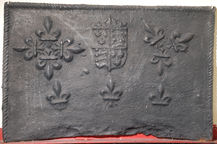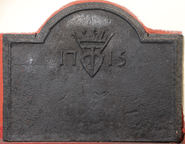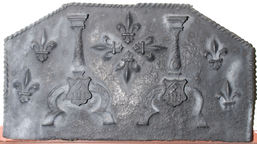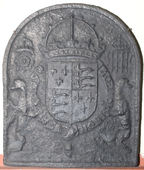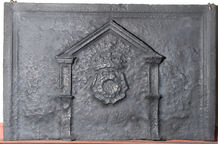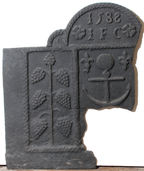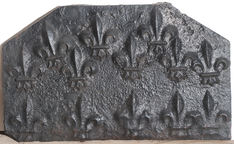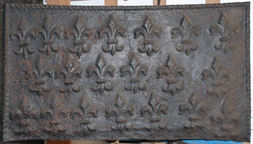-
384
Description: Rectangular; twisted rope edge on top and sides; crowned Tudor royal shield between fleurs de lys arranged in a four-pointed star shape on left, in a three-pointed star shape on right, and three singly in a line below.
Notes: The crowned shield is seen on several firebacks, indicating that they were products of the same furnace.
Arms: Tudor royal arms of England
- Decoration tags:
- rectangular (shape)
- rope (edging)
- carved stamps
- heraldic
- armorial
Manufactured: in the mid-16th century in the Weald area of England.
Current location: Anne of Cleves House, Southover High Street, Lewes, East Sussex, England.
Museum number: 1944.24.034 (part of the Sussex Archaeological Society museum group)
Citation: Dawson, C., 1903, 'Sussex Iron Work and Pottery', Sussex Archaeological Collections, 46, pp. 1-54.
- Attached to series:
- Royal series
-
389
Description: Arched rectangular shape; plain edge with inset astragal on all sides; stylised buckle surmounted by an earl’s coronet between the two halves of the date.
Notes: The buckle is the badge of the Pelham family and the earl’s coronet may refer to the Earldom of Clare to which Thomas Pelham-Holles, 2nd Baron Pelham of Laughton was raised in 1714. The following year he was created Marquess of Clare and Duke of Newcastle-upon-Tyne. Formerly part of the J. H. Every collection.
Inscription: 17 15
- Decoration tags:
- rectangular with round arch (shape)
- flanged (edging)
- carved stamps
- individual numbers
- heraldic
- text
Manufactured: in 1715 in the Weald area of England.
Current location: Anne of Cleves House, Southover High Street, Lewes, East Sussex, England.
Museum number: 1944.24.084 (part of the Sussex Archaeological Society museum group)
- Attached to series:
- Pelham family firebacks
-
393
Description: Rectangular with canted top corners; twisted rope edging all round except base: plain plate with two stamps of an iron firedog with twisted neck and shield bearing letters HN and crossed staples; firedogs have columnar capitals; fleur de lys stamp repeated six times, singly at each end, in star pattern in middle; stamps have twisted wreaths.
Notes: The initials HN probably refer to Henry Nevill, the crossed staples being a badge of the Nevill family. Henry Nevill occupied Mayfield furnace from about 1585 until 1599. One of two variants (see no. 742) with the same firedogs and fleurs-de-lys; other firedogs in a very similar style are known. Formerly at Holmbush Farm, Hellingly, Sussex.
Inscription: HN HN
- Decoration tags:
- rectangular with canted top corners (shape)
- rope (edging)
- simple stamps
- carved stamps
- heraldic
- text
- objects
Manufactured: in the late-16th century possibly at Mayfield Furnace in the Weald area of England.
Current location: Anne of Cleves House, Southover High Street, Lewes, East Sussex, England.
Museum number: LH000.902 (part of the Sussex Archaeological Society museum group)
Citation: Anon., 30 Dec 1911, 'Sussex Backs and their Story', The Ironmonger.
Citation: Dawson, C., 1903, 'Sussex Iron Work and Pottery', Sussex Archaeological Collections, 46, pp. 1-54.
Citation: Gardner, J. S., 1898, 'Iron Casting in the Weald', Archaeologia, 56, 1, pp. 133-164.
- Attached to series:
- Henry Nevill series
- Firedog stamp firebacks
- Metalware stamp firebacks
-
397
Description: Arched; fillet edging; Tudor royal shield, garter, crown and supporters (dragon and greyhound); top left, crowned Tudor rose; top right, crowned portcullis (grid of 6).
Notes: There are several firebacks with the Tudor royal arms that were probably produced in the Spanish Netherlands, perhaps illustrating the association between England and Spain through the marriage of Henry VIII and Katherine of Aragon. The firebacks differ in several small details, such as the form and rotation of the Garter motto, the style of the crown, the positioning of the supporters in relation to the Garter, and the form and size of the crowned rose and portcullis.
Copies of this fireback are known.
Inscription: HONI SOIT QVI MAL I PENSE
Arms: Tudor royal
- Decoration tags:
- rounded arched (shape)
- fillet (edging)
- whole carved pattern
- heraldic
- armorial
- royal
- text
Manufactured: in the mid-16th century possibly in the Wallonia area of Luxemburg.
Current location: Anne of Cleves House, Southover High Street, Lewes, East Sussex, England.
Museum number: LH000.915 (part of the Sussex Archaeological Society museum group)
Citation: Lloyd, N., 1925, 'Domestic Ironwork I', Architectural Review, 58, pp. 58-67.
- Attached to series:
- Tudor royal armorial firebacks
- Continental Tudor royal armorial firebacks
-
398
Description: Rectangular; cyma curve and fillet edging; crowned Tudor rose within a pediment resting on Tuscan pilasters and pedestals.
Notes: The rose and crown are more finely modelled than other versions.
Copies of this fireback are known.
- Decoration tags:
- rectangular (shape)
- cyma curve and fillet (edging)
- whole carved pattern
- heraldic
- architectural
- royal
Manufactured: in the mid- to late-16th century in the Weald area of England.
Current location: Anne of Cleves House, Southover High Street, Lewes, East Sussex, England.
Museum number: LH000.942 (part of the Sussex Archaeological Society museum group)
- Attached to series:
- Miscellaneous royal firebacks
- Pedimented rose and crown series
-
438
Description: Rectangular with three sided arch; astragal edging; lion rampant crest beaneath a crown; the date split either side of the lion's head.
Notes: The evenness of the casting, the form of the crown and the lion all suggest that the date is spurious.
Copies of this fireback are known.
Inscription: 16 39
- Decoration tags:
- rectangular with three-facetted arch (shape)
- astragal (edging)
- carved stamps
- individual numbers
- heraldic
- royal
- text
Manufactured: in the early- to mid-20th century in England.
Current location: Anne of Cleves House, Southover High Street, Lewes, East Sussex, England.
(part of the Sussex Archaeological Society museum group)
- Attached to series:
- Miscellaneous stamp firebacks
-
439
Description: Fragment; left part only; this fireback comprises at least four separate elements: the rectangular central panel has an anchor with coiled rope between two fleurs de lys, below which are two roses; the rectangular side panels each comprise a vertical stem with six ‘grape bunches’ surmounted by a circular grape cluster; above, a semicircular arch contains the initials between two roses as in the central panel, with the date above; where the arch meets the central panel there is an arc across each corner. The side and top panels are edged with simulated twisted rope; to the left and botoom, a plain extension has been added before casting.
Notes: One of an unusual series formed from separate panels. The left panel is likely to have been repeated in the missing section. The extensions to the side and bottom will be unique to this casting which, because of the sharpness of the relief detail, is probably an early example. Because of its date and the use of the anchor motif, this much-copied plate is often referred to as the Armada fireback. No other connection with the sea battle is known. Other firebacks have been cast using some of the separate elements described.
Inscription: 1588 / IFC
- Decoration tags:
- rectangular with round arch (shape)
- none (edging)
- carved pattern panels
- heraldic
- text
- plants
- objects
Manufactured: in 1588 in the Weald area of England.
Current location: Anne of Cleves House, Southover High Street, Lewes, East Sussex, England.
Museum number: 1944.24.060 (part of the Sussex Archaeological Society museum group)
- Attached to series:
- Armada series
-
442
Description: Fragment: right part only; rectangular; twisted rope edging; lion passant with rose stamped twice above and below rear end, crowned rose below fore end; bottom right corner, two small walking figures, one with both arms down, the other with right arm raised.
Notes: One of a series with the same and other stamps.
- Decoration tags:
- rectangular (shape)
- rope (edging)
- carved stamps
- heraldic
- royal
- animals
- humans
- plants
Manufactured: in the mid-16th century in the Weald area of England.
Current location: Anne of Cleves House, Southover High Street, Lewes, East Sussex, England.
Museum number: LH001.005 (part of the Sussex Archaeological Society museum group)
- Attached to series:
- Royal series
-
443
Description: Canted rectangle; plain plate with two rows of fleurs de lys, eight in the top row, three off set above the other five, and five in a single row along the bottom.
Notes: The fleurs-de-lys are the same as are seen on firebacks thought to have been cast at Pounsley.
- Decoration tags:
- rectangular with canted top corners (shape)
- none (edging)
- carved stamps
- heraldic
Manufactured: in the mid- to late-16th century possibly at Pounsley Furnace, Framfield in the Weald area of England.
Current location: Anne of Cleves House, Southover High Street, Lewes, East Sussex, England.
(part of the Sussex Archaeological Society museum group)
Citation: Butterfield, W. R., 1916, 'Old Wealden Firebacks', The Connoisseur, 46, pp. 197-209.
- Attached to series:
- Pounsley series
-
448
Description: Rectangular; twisted rope edging (top and sides); fleur de lys arranged in a pattern of 20, in three rows: 7-6-7.
Notes: A type of fleur-de-lys used on firebacks possibly cast at Pounsley Furnace.
- Decoration tags:
- rectangular (shape)
- rope (edging)
- carved stamps
- heraldic
Manufactured: in the mid- to late-16th century possibly at Pounsley Furnace, Framfield in the Weald area of England.
Current location: Hall Place, Bexley, Kent, England.
Museum number: 1944.24.039 (part of the Sussex Archaeological Society museum group)
- Attached to series:
- Pounsley series
